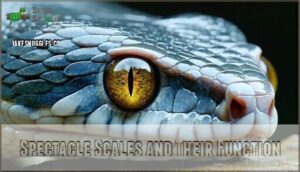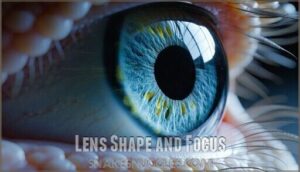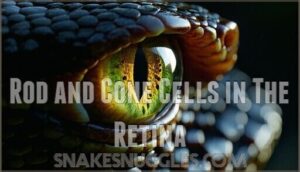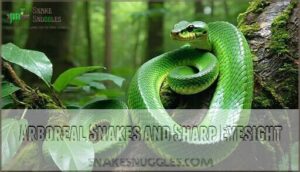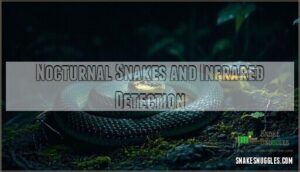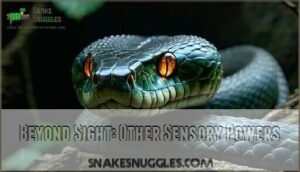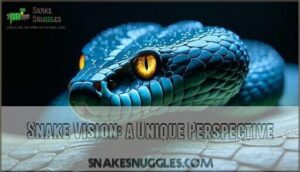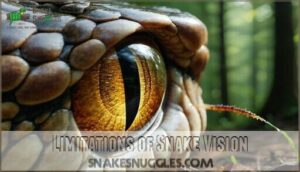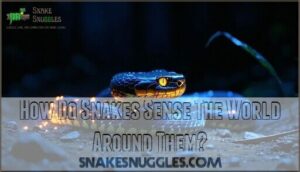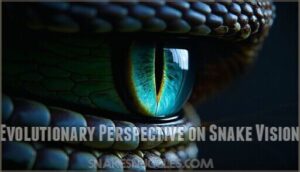This site is supported by our readers. We may earn a commission, at no cost to you, if you purchase through links.
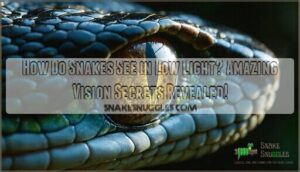
You’ll find their retinas contain far more rods than cones, making them perfect night hunters but limiting color vision to just two primary colors.
Their transparent spectacle scales protect eyes while allowing maximum light entry, and most snakes can even detect ultraviolet light, giving them an edge in darkness that humans lack.
This rod-heavy setup means they’re masters at spotting prey movement in dim conditions, though they sacrifice sharp detail for light sensitivity.
What’s really fascinating is how different snake species have evolved specialized visual tricks.
Table Of Contents
- Key Takeaways
- How Snakes See in Low Light
- Snake Eye Anatomy
- Snake Vision in Different Environments
- Beyond Sight: Other Sensory Powers
- Snake Vision: a Unique Perspective
- Limitations of Snake Vision
- How Do Snakes Sense The World Around Them?
- Snake Vision and Behavior
- Evolutionary Perspective on Snake Vision
- Frequently Asked Questions (FAQs)
- How do snakes see in the dark?
- Should I leave a light on for my snake at night?
- How well can snakes see at night?
- Can snakes see in low light?
- Can snakes see in the dark?
- How do snakes see?
- Do snakes have night vision?
- What does a snakes vision look like?
- Can you see snakes with night vision?
- Do snakes have dark vision?
- Conclusion
Key Takeaways
- You’ll see movement and heat better than colors – Snake eyes contain 80% rod cells versus cone cells, giving them 2,500 times better light sensitivity than humans, but limiting them to just two primary colors.
- You’re protected by built-in goggles that shed – Transparent spectacle scales replace eyelids, maximizing light entry while protecting eyes from debris, and these scales completely shed during molting every 4-8 weeks.
- You can detect infrared heat signatures – Pit organs between eyes and nostrils sense temperature differences as small as 0.003°C, letting you "see" warm-blooded prey as glowing heat maps in complete darkness.
- You’ll trade sharp detail for motion detection – Rod-heavy retinas excel at spotting movement and shadows invisible to humans, making you a master night hunter, despite sacrificing crisp visual resolution.
How Snakes See in Low Light
You’ve probably wondered how snakes navigate and hunt effectively when darkness falls around them.
These remarkable reptiles possess specialized visual adaptations that make them incredibly efficient predators in low-light conditions, using both enhanced night vision and unique sensory abilities that go far beyond what human eyes can detect, with incredibly efficient abilities.
Adaptation of Snake Vision
You’ve probably wondered how snakes navigate darkness so effortlessly.
Their snake eye adaptations showcase remarkable evolutionary strategies shaped by environmental pressures.
Snake retinas contain abundant rod cells that boost visual acuity in low light vision, detecting movement and shadows invisible to you.
These nocturnal snakes evolved specialized lenses and transparent scales protecting their eyes.
While their color perception remains limited, this trade-off maximizes hunting success in dim conditions.
Some species even developed infrared vision through pit organs, creating a biological night-vision system that transforms snake vision into a formidable predatory advantage.
Evolution of Snake Visual Abilities
You’ve seen how snakes adapted their vision, but their snake vision evolution tells an even deeper story.
Early snakes experienced Visual Regression when they evolved from burrowing ancestors, losing some visual abilities their lizard relatives kept.
However, this setback sparked remarkable snake visual adaptations.
Modern snakes developed specialized nocturnal adaptations like enhanced rod cells for low-light hunting.
Diurnal Adaptations emerged in day-active species, while Arboreal Acuity sharpened focus for tree-dwellers.
Some developed Infrared Origins through pit organs, creating thermal vision.
Research shows snake eye adaptations involved significant changes in visual pigment genes.
This Color Vision evolution shaped how different species perceive their world, proving evolution’s remarkable ability to customize snake vision for survival.
Impact on Hunting Strategies
Through clever nocturnal hunting strategies, you’ll find snakes use infrared vision and thermal vision to detect warm-blooded prey in darkness.
Snake hunting combines ambush tactics with precise strike precision, where visual cues trigger lightning-fast attacks.
Nocturnal snakes excel at prey detection using heat signatures, making them incredibly effective nighttime predators despite limited color vision.
Snake Eye Anatomy
You’ll discover that snake eyes work quite differently from yours, with specialized features that make low-light vision possible.
Their unique anatomy includes protective spectacle scales instead of eyelids, spherical lenses for sharper focus, and retinas packed with light-sensitive rod cells.
Spectacle Scales and Their Function
Now that you understand how snakes adapt their vision for low-light conditions, let’s examine the unique protective features that make this possible.
Snake eye protection starts with spectacle scales – transparent coverings that replace traditional eyelids. Think of them as built-in safety goggles that never come off.
These remarkable snake adaptations work differently from your eyelids:
- Spectacle Protection: Clear, fixed scales shield eyes from debris, scratches, and environmental hazards
- Shedding Frequency: Scales shed completely during molting, typically every 4-8 weeks depending on species
- Vision Clarity: Fresh scales guarantee unobstructed sight, like getting new prescription glasses regularly
- Scale Composition: Made of keratin, they’re tougher than regular skin but remain perfectly transparent
Without proper shedding, old spectacle scales accumulate and cloud vision – imagine trying to see through dirty windows.
This evolutionary significance can’t be overstated; these scales allow snakes to maintain sharp vision while protecting their eyes in harsh environments.
The seamless integration of snake anatomy shows how snake vision evolved to be both protective and functional, guaranteeing these predators can hunt effectively while keeping their eyes safe from harm.
Lens Shape and Focus
Unlike human eyes, your snake’s spherical lens acts like a precision camera, delivering razor-sharp focus that puts our vision to shame.
This remarkable snake lens composition creates superior image clarity through advanced accommodation mechanisms. The spherical lenses evolved specifically for enhanced snake visual clarity, making their snake focus mechanism incredibly efficient.
These focus sharpness benefits give snakes distinct advantages in detecting movement and tracking prey with unmatched precision.
Maintaining proper humidity prevents retained eye caps.
Rod and Cone Cells in The Retina
Your snake’s retina contains specialized photoreceptor cells that create their amazing low-light vision.
Rod cells dominate the retina at roughly 80%, maximizing light sensitivity for detecting movement in dim conditions.
These cells contain rhodopsin that regenerates slowly, enhancing nighttime hunting abilities.
Cone cells remain sparse but enable limited color perception, with diurnal species having higher cone density than nocturnal ones for improved daylight vision.
Snake Vision in Different Environments
You’ll discover that snakes have evolved remarkably different visual systems depending on where they live and when they’re active.
From tree-dwelling species with razor-sharp eyesight to nocturnal hunters using infrared heat detection, each snake’s vision perfectly matches its lifestyle and hunting needs.
Arboreal Snakes and Sharp Eyesight
Visual acuity reaches its peak in arboreal snakes, who’ve mastered the art of tree-dwelling survival.
You’ll find these sharp-eyed hunters traversing complex canopies with remarkable precision, their enhanced snake vision allowing them to spot prey and judge distances between branches.
Evolutionary pressures shaped their exceptional color perception and visual acuity, making them perfectly adapted for hunting strategies that require split-second decisions in their three-dimensional habitat.
Nocturnal Snakes and Infrared Detection
While tree-dwelling snakes rely on sharp eyesight, nocturnal snakes have mastered darkness through infrared detection.
Pit vipers possess specialized pit organ sensitivity that detects temperature changes as small as 0.003°C.
This heat sensing creates detailed thermal image processing, allowing precise infrared hunting tactics.
Their heat signature detection transforms complete darkness into a warm-blooded prey map, making nocturnal snake behavior incredibly efficient for nighttime hunting success.
Diurnal Snakes and UV Vision
When you step into the domain of diurnal snakes, you’ll discover they’ve mastered daylight hunting through remarkable UV sensitivity.
These day-active serpents possess specialized UV-sensitive cone cells that make up 10-15% of their total cone cells, with peak sensitivity around 360-380 nanometers. This adaptation gives them a significant edge in bright environments.
Here’s what makes their UV vision so powerful:
- Enhanced prey detection – They spot small reptiles and amphibians that reflect UV light, increasing hunting success rates
- Superior navigation – UV patterns on plants and surfaces help them identify ideal habitats and territories
- Social communication – UV cues assist in mate selection and territorial displays
Diurnal snakes’ visual acuity surpasses their nocturnal cousins, with higher cone cell concentrations in their retinas. Their lenses effectively transmit UV light, while color perception extends beyond human capabilities.
Some species exhibit dichromatic color vision, allowing them to perceive a limited range of colors. This arboreal vision adaptation proves that light sensitivity isn’t just about seeing in darkness—it’s about maximizing every wavelength available during peak daylight hours.
Beyond Sight: Other Sensory Powers
You might think snakes rely only on their eyes to navigate the dark, but they’ve got a whole toolkit of incredible sensory superpowers that make human senses look pretty basic.
These remarkable reptiles use heat-detecting pit organs, chemical-sensing tongues, and vibration-detecting abilities to create a complete picture of their world that goes far beyond what any pair of eyes could provide, utilizing their senses to build a more complete picture of their environment.
Infrared Detection Through Pit Organs
Picture yourself in complete darkness, yet you can still "see" every warm creature around you. That’s exactly what pit organs give snakes like pit vipers. These remarkable heat-sensing pits sit between their eyes and nostrils, acting like biological thermal cameras.
Pit organ anatomy is fascinating—specialized membranes detect infrared radiation from warm-blooded animals. The thermal image processing happens instantly, creating a heat map in the snake’s brain. When you’re dealing with prey heat signatures, even a mouse’s body warmth glows like a beacon against the cool ground.
Pit viper evolution perfected this infrared hunting tactics system over millions of years. You can even find products related to viper organ systems online. Their infrared vision can detect temperature differences as tiny as 0.003°C. You’d be amazed how this infrared detection turns complete darkness into a hunting advantage, making these snakes incredibly effective nocturnal predators.
Smell and Scent Receptors in The Mouth
Beyond heat detection, you’ll discover snakes possess an extraordinary chemical sensing system through their Vomeronasal Organ, commonly called Jacobson’s organ.
When snakes flick their tongues, they’re collecting chemical signals for scent tracking and prey identification.
Here’s how this olfactory perception works:
- Tongue flicking captures airborne molecules and scent trails
- Chemical sensing occurs when the tongue transfers particles to roof-mounted receptors
- Olfactory navigation creates detailed scent maps for hunting and survival
This chemical sensing ability lets snakes "taste" their environment with remarkable precision.
Specialized cells contribute to snake chemoreception mechanisms.
Vibration Sensitivity and Prey Detection
Snakes feel ground vibrations through specialized mechanoreceptors in their bodies.
When prey moves nearby, vibrations travel through substrate coupling – basically bone conduction through the ground.
This vibration detection works like nature’s seismic communication system, alerting snakes to approaching meals or threats.
It’s incredibly sensitive, helping with both snake hunting techniques and snake defensive behaviors when eyesight fails.
Snake Vision: a Unique Perspective
You might think snakes see the world just like you do, but their vision works completely differently from human sight.
While your eyes rely heavily on color and detail, snakes have evolved specialized visual systems that prioritize movement detection and light sensitivity over the sharp, colorful images you’re used to seeing, which emphasizes movement detection.
Distinct From Human Vision
Everything about snake vision differs dramatically from your own visual experience.
Their unique adaptations create a completely different way of seeing the world.
Key differences include:
- Spectacle Scales: Instead of blinking eyelids, snakes have transparent protective scales that shed with their skin
- Lens Shape: Spherical lenses provide sharper focus than your flatter human lenses
- Rod Density: Packed with light-detecting rod cells for exceptional seeing in darkness
- Color Perception: Most species see limited colors, detecting mainly blue wavelengths
- Infrared Sensing: Pit organs give nocturnal snakes "heat vision" to spot warm-blooded prey
This infrared vision lets them hunt effectively when you’d be stumbling around blind.
Rod and Cone Cells in Snake Eyes
Unlike human vision, snake retina function relies heavily on specialized cells.
Most snakes have rod cells that dominate their retinal composition, providing incredible rod sensitivity for light detection in lowlight conditions. These rods outnumber cone cells substantially, giving snakes their remarkable night vision abilities.
Cone function handles color perception, though it’s limited—most species see only two primary colors, creating dichromatic snake vision that’s perfectly adapted for survival.
Snake species, however, show varied adaptations to diverse environments.
Evolutionary Adaptation of Snake Vision
Millions of years shaped how you’d find snake vision today through remarkable evolutionary pressures and sensory trade-offs.
Early snakes experienced ancestral vision loss, trading detailed color perception for specialized abilities that suit their hunting lifestyle.
Here’s how evolution crafted their unique visual system:
- Visual pigment genes underwent substantial changes, altering light wavelength sensitivity for habitat-specific vision adaptations
- Infrared vision emerged as a game-changing advantage, letting snakes detect warm-blooded prey in complete darkness
- Sensory trade-offs prioritized movement detection and heat sensing over color discrimination, perfectly matching their nocturnal hunting needs
This evolutionary journey transformed snake senses into precision instruments optimized for survival.
Limitations of Snake Vision
While you might expect snakes to have poor vision, they’ve actually developed remarkable adaptations that come with specific trade-offs.
Despite their incredible low-light abilities and heat detection, snake vision has distinct limitations that shape how they navigate their world, which is a result of their incredible low-light abilities.
Narrow Field of View
Picture a security camera with a fixed lens—that’s how eye placement affects snake vision.
You’ll find their eyes positioned on the sides of their heads, creating significant field limitations and visual restrictions.
This narrow field of view means they can’t see directly in front like you can.
However, snakes compensate through strategic head movement, lifting their heads to scan without exposing their entire body.
Their peripheral vision excels at detecting movement, making this adaptation perfect for nocturnal hunting despite reduced visual acuity in low light conditions.
Limited Color and Detail Perception
While narrow field of view presents one challenge, snake vision faces another major limitation you’d find fascinating. Your pet snake can’t see the world in vibrant color like you do.
Most snakes experience monochromatic vision due to their rod-dominated retinas, which prioritize low light sensitivity over color detection.
Here’s what limits their visual acuity:
- Rod cells outnumber cone cells dramatically in most species
- Limited color perception restricts them to basic hues
- Detail perception suffers compared to human standards
- Trade-off favors motion detection over fine visual details
This dim light sensitivity advantage comes at a cost—snake vision sacrifices colorful detail for superior nighttime hunting abilities.
Enhanced Light Sensitivity
Enhanced Light Sensitivity creates a fascinating trade-off in snake vision.
Your garden snake’s rod cells work like biological night-vision goggles, packed densely in the retina for incredible low light detection.
This sensory adaptation lets snakes spot moving prey during night hunting when most animals can’t see a thing.
However, this dim light sensitivity comes with a catch – you’re trading sharp detail for movement detection.
Think of it like watching a grainy security camera feed; you’ll catch the action but miss the fine print.
While snake eyesight excels in darkness, it sacrifices the crisp resolution humans enjoy in bright conditions.
How Do Snakes Sense The World Around Them?
You might think snakes only rely on their eyes, but they’ve developed an incredible toolkit of senses that goes far beyond basic vision.
While their rod-dominated retinas excel at detecting movement in dim conditions, snakes also use infrared detection to sense heat signatures and create detailed scent maps through their forked tongues, utilizing infrared detection.
Basic Sight and Movement Detection
You’ll notice that snakes have remarkable movement detection abilities, even in low light conditions.
Their eye structure contains mostly rod cells, which excel at detecting motion and light changes rather than fine details.
This snake eyesight adaptation gives them exceptional night vision and visual acuity for spotting moving prey or predators.
Think of it like having built-in motion sensors—snakes can catch the slightest movement against backgrounds, making them incredibly effective hunters in dim environments where low light vision becomes essential for survival.
Infrared Detection and Temperature Sensing
Snakes possess incredible infrared vision that functions like built-in thermal imaging cameras.
Their pit organs, specialized sensors between their eyes and nostrils, detect infrared radiation from warm-blooded prey.
This heat sensing ability allows thermal sensing of temperature differences as small as 0.003°C.
During night hunting, this infrared sensing gives snakes a massive advantage, letting them track prey through heat detection even in complete darkness.
Scent Perception and Olfactory Map
Beyond detecting heat signatures, you’ll discover that snakes navigate their world through sophisticated olfactory systems that create detailed scent maps.
Their forked tongues constantly sample air molecules, transferring chemical cues to specialized sensory receptors called Jacobson’s organs. This chemical sensing mechanism processes pheromone signals and scent trails like a biological GPS system.
Picture these scent-detecting superpowers:
- Chemical highways: Invisible scent trails crisscross their territory like roadways
- Molecular fingerprints: Each creature leaves unique chemical signatures snakes can identify
- Time-stamped messages: Fresh versus old scent markings reveal when prey passed through
- Weather-resistant tracking: Chemical communication persists even after visual evidence disappears
This olfactory biology transforms how snakes experience their environment. While you might see an empty forest floor, a snake detects a rich tapestry of chemical information—recent prey movements, territorial boundaries, and potential mates.
Their smell detection capabilities far exceed human abilities, making scent their primary navigation tool alongside their remarkable vision adaptations.
Snake Vision and Behavior
You’ll discover how snakes’ incredible vision shapes every aspect of their survival, from hunting prey in complete darkness to avoiding deadly predators.
Their unique visual adaptations create behaviors that seem almost supernatural, allowing them to thrive in environments where other animals would be helpless, due to their ability to survive in darkness.
Hunting Strategies and Prey Detection
Precision transforms a snake’s hunt into an art form.
You’ll notice how different species employ specialized hunting tactics based on their unique visual abilities and environmental needs.
Arboreal snakes use their excellent eyesight for prey location from treetops, while nocturnal hunters master stealth attacks through infrared sensing and thermal imaging capabilities.
Snake Type Hunting Strategy
Night vision becomes essential when you’re hunting in low light conditions.
Pit vipers combine thermal imaging with traditional sight, creating a deadly combination for prey detection in complete darkness.
Defense Mechanisms and Predator Avoidance
When you’re not actively hunting, you need to stay alive yourself.
Snakes have developed impressive defense mechanisms and predator avoidance strategies that rely heavily on their exceptional sensory abilities, especially their infrared sensing and night vision capabilities in low light conditions.
Your survival toolkit includes several key stealth behavior patterns:
- Camouflage Tactics: You’ll blend perfectly with leaves, bark, or sand, becoming nearly invisible to predators scanning the area
- Threat Displays: When cornered, you’ll coil up, hiss loudly, or show bright warning colors to appear larger and more dangerous
- Escape Strategies: Your flexible body lets you slip through tight spaces and move quickly across various terrains when danger approaches
- Venom Defense: As your last resort, you can deliver a powerful bite that’ll stop most attackers in their tracks
These defense mechanisms work together seamlessly.
Your ability to detect heat signatures helps you spot approaching threats before they see you, while your excellent movement detection alerts you to danger from any direction, even in complete darkness.
Understanding snake night vision systems is essential to appreciating their unique adaptations.
Visual Acuity and Environmental Adaptation
Throughout the animal kingdom, you’ll find that snake visual acuity development reflects remarkable Environmental Pressures and Sensory Evolution.
Each species’ Eye Structure adapts to their hunting grounds and lifestyle needs.
| Environment | Visual Adaptation |
|---|---|
| Treetops | Sharp focus for branch navigation |
| Desert floors | Enhanced Low Light Vision capabilities |
| Water habitats | Flexible visual system adjustment |
Arboreal snakes develop exceptional snake visual acuity development for precise movements through branches.
Meanwhile, nocturnal hunters prioritize snake infrared sight over color detection.
Their visual system incorporates specialized snake UV lenses that filter harmful radiation while maintaining light sensitivity.
This Visual Adaptation showcases how low light conditions shaped these predators’ remarkable sensory abilities.
Evolutionary Perspective on Snake Vision
You’ve probably wondered how snakes managed to survive and thrive despite having such different vision from other animals.
The story of snake vision evolution reveals how these reptiles developed unique visual adaptations that actually gave them advantages over their ancient ancestors who relied heavily on sight.
Early Snake Evolution and Visual Regression
Looking at fossil records, you’ll discover that early snakes likely descended from burrowing or aquatic ancestors with reduced visual regression.
These ancient eyes weren’t built for low light hunting like today’s nocturnal creatures.
Snake origins reveal fascinating evolutionary tradeoffs – they sacrificed sharp color vision for specialized abilities like infrared sensing.
Modern snake vision reflects millions of years adapting to underground and underwater environments where sight mattered less than other senses.
Diverse Visual Adaptations in Reptiles
Reptiles showcase remarkable diversity in their visual adaptations. While snakes excel at infrared sensing and movement detection for night vision, lizards developed extraordinary color perception.
This contrast reveals how eye evolution shaped different survival strategies. Snake retina structure prioritizes rod cells for low light detection, while their snake scales protect specialized reptile eyes.
Visual adaptations across reptiles include:
- Enhanced visual acuity in diurnal species
- Specialized snake vision for heat detection
- UV-sensitive vision in some lizards
- Motion-detecting capabilities for predator avoidance
Study on Snake Visual Pigment Gene Changes
Recent breakthroughs in molecular biology have revealed fascinating changes in snake visual pigment genes that explain their exceptional low light vision abilities.
Scientists discovered that snakes lost the SWS2 opsin gene found in other reptiles, dramatically reducing their color vision capabilities. However, this wasn’t a loss—it was strategic evolution.
Key genetic discoveries include:
- Gene Expression patterns differ substantially between nocturnal and diurnal snake species
- Visual Mutations in opsin genes shifted spectral tuning for crepuscular environments
- Pigment Genetics show LWS opsin gene duplications in specific snake lineages
- Eye Development relies on highly conserved RH1 genes that enhance snake night vision
These molecular biology findings explain why snake visual perception excels in darkness. The evolutionary trade-off sacrificed color discrimination for superior snake infrared vision and movement detection—perfectly suited for nocturnal hunting strategies that rely on snake low light vision rather than detailed visual information.
Understanding snake vision types is vital to appreciating the complexity of their visual system and its adaptations to different environments.
Frequently Asked Questions (FAQs)
How do snakes see in the dark?
Snakes don’t truly "see" in darkness like you might think.
Instead, they’ve got rod-dominated retinas that detect light 2,500 times better than yours, plus specialized pit organs that sense infrared heat from warm-blooded prey.
Should I leave a light on for my snake at night?
No, you don’t need to leave a light on for your snake at night.
Snakes have excellent night vision thanks to abundant rod cells in their retinas, making them naturally adapted for low-light conditions.
How well can snakes see at night?
Most snakes excel at nighttime vision through rod-rich retinas that detect movement and light 2,500 times better than humans can see in darkness.
Can snakes see in low light?
Yes, snakes excel in low-light conditions thanks to rod-dominated retinas packed with light-sensitive cells.
You’ll find they see 2,500 times better than humans in darkness, using rhodopsin proteins that maximize available light for nighttime hunting.
Can snakes see in the dark?
Absolutely incredible vision gives you a major advantage in darkness.
You’ll see remarkably well thanks to rod-dominated retinas packed with light-sensitive cells, plus some species use infrared pit organs for heat detection.
How do snakes see?
Through specialized eyes equipped with transparent spectacle scales, snakes detect light and movement using rod-dominated retinas.
Their spherical lenses provide sharp focus, while many species use infrared-sensing pit organs to "see" heat signatures from warm-blooded prey in complete darkness, utilizing infrared-sensing pit organs.
Do snakes have night vision?
Like thermal goggles for hunters, you’ll find that snakes possess remarkable night vision through rod-dominated retinas and specialized pit organs that detect infrared radiation from warm-blooded prey.
What does a snakes vision look like?
You’d see a world dominated by movement and heat signatures rather than sharp colors.
Snake vision emphasizes detecting motion and thermal radiation over detailed imagery, creating a grayscale landscape punctuated by warm-blooded targets, highlighting the importance of thermal detection in this unique visual perspective.
Can you see snakes with night vision?
Yes, you can spot snakes with night vision devices since they emit body heat.
However, snakes themselves see much better than you in darkness thanks to rod-dominated retinas and infrared-sensing pit organs.
Do snakes have dark vision?
Darkness doesn’t defeat them, light doesn’t define them, vision doesn’t confine them.
You’ll find snakes excel in darkness through rod-dominated retinas containing 2,500 times more light-sensitive cells than humans, plus infrared-detecting pit organs that sense heat signatures.
Conclusion
Like a master locksmith crafting the perfect key for darkness, evolution has forged snake vision into a specialized tool for low-light survival.
Their rod-packed eyes sacrifice color detail for incredible movement detection, while spectacle scales maximize light entry.
Understanding how do snakes see in low light reveals nature’s ingenious solutions – trading sharp focus for enhanced sensitivity.
Combined with infrared detection and chemical sensing, snakes navigate their world through a sensory symphony we’re only beginning to appreciate.

